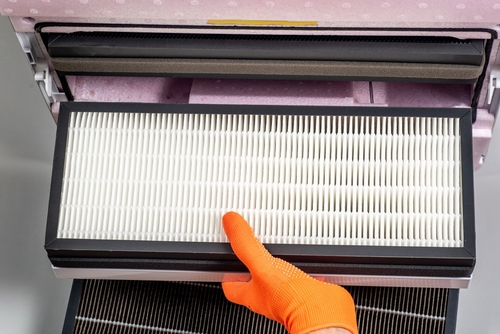June 5, 2025
What are VOCs, and How Can You Protect Yourself From Them?
There’s always lots of talk about outdoor air pollution. However, various studies have shown that indoor air quality can be much worse, and volatile organic compounds (VOCs) are common contributors.
Here’s what you need to know about these pollutants.

What Are VOCs?
A volatile organic compound is a chemical containing carbon that becomes a gas at room temperature. These chemicals are found in plastics, personal care products, paints, solvents, furniture, and more. Newer items off-gas, or emit VOCs, at a higher rate. For example, this is why your brand-new car might have that “new car” smell, or when you get a new piece of furniture, it can take a few days to air out.
Common VOCs and Risks
Because VOCs are emitted slowly, research is ongoing. But long-term exposure to VOCs is thought to be behind a number of health issues. The list is long, but here are three VOCs that we know about, and their health effects.
Benzene has a sweet odor and is very flammable. It occurs in nature and is commonly used in the manufacturing processes of plastics, resins, fibers, lubricants, rubber, detergents, and dyes. Due to its extensive use, it’s one of the highest-produced chemicals in the US. Unfortunately, benzene is a known carcinogen (cancer-causing substance) and it can affect the immune and nervous systems.
Formaldehyde is a pungent chemical used for fertilizers, paper production, some resins, and as a preservative in cosmetics, certain foods, antiseptics, and medication. It’s also produced in small amounts by the human body. Too much exposure can lead to cancer. In addition, it affects the lungs, skin, immune system, and digestive system.
Acetone is present in the environment and is produced from manufacturing processes. It’s used for plastics, fibers, and to dissolve substances. Its ability to dissolve various materials makes it useful as a nail polish remover, which is one common use. It occurs in the breakdown of body fat, but excess exposure affects the blood and nervous systems.
How to Minimize Exposure

The best way to reduce exposure is through increased ventilation, which removes contaminated air and replaces it with fresh outside air. Opening windows more frequently in mild weather is one way to reduce VOC buildup. Store unused paints or chemicals in a garage or shed where people are less likely to breathe them in—or better yet, throw them out. Additionally, consider purchasing low-VOC products where available, such as paints and furniture.
While household air cleaners can seem like a promising VOC solution, studies have shown that they may not be as effective as promised and may in fact contribute to household VOCs. However, physical filters or absorbent materials can trap VOCs, like the filters found within your HVAC system. An air purifier for VOCs may be a better choice than an air cleaner.
Your HVAC system should be optimized to provide enough ventilation through exhaust and fresh air supply that’s filtered and conditioned. Without this, VOCs can build up in your home. Be sure to change your filter every month or two.
If you’re concerned about VOCs and want to improve the air quality in your home, give Applewood a call! We can consult with you on VOC air purifier and HVAC installation, cleaning, and maintenance.
Frequently Asked Questions
What Does VOC Stand For?
VOC stands for Volatile Organic Compound. It’s a collective term that’s used to describe many individual compounds.
What Level of VOC Is Dangerous?
According to Tecam Group, an environmental technology company that specializes in emissions reduction, low VOC levels are considered to be less than 0.3mg/m3, while high levels are 1 mg/m3 or higher.
| VOC Level (mg/m3) | Level of Concern |
| Less than 0.3 | Low |
| 0.3 to 0.5 | Acceptable |
| 0.5 to 1 | Marginal |
| 1 to 3 | High |
Does a Carbon Filter Remove VOCs?
Yes, carbon filters are shown to remove VOCs from the air. Activated carbon may be especially effective due to its porous structure, which allows it to absorb VOC molecules and prevent them from circulating. However, the amount of carbon needed can depend on the VOC air purifier’s capacity and the concentration of VOCs in the air.
Concerned about VOCs in your home? Call Applewood for a consultation!


